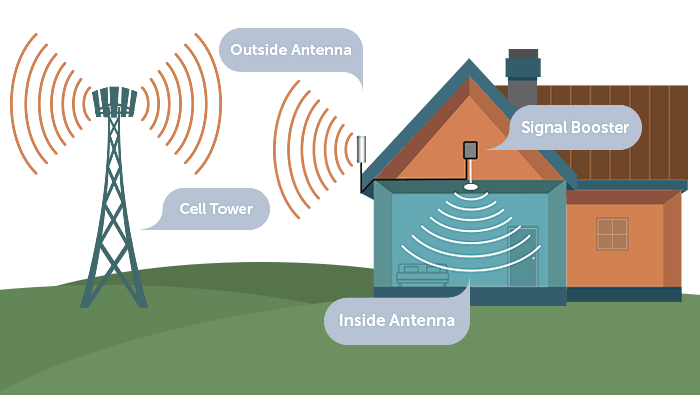Having dependable cell phone service is more than just a convenience in today’s hyperconnected society; it is a need. Strong cellular coverage isn’t available to everyone, though, particularly in rural locations with sparse cell towers. Geographical barriers, remote locations from cell towers, and sparse populations all contribute to poor signal reception in rural places. This is where cell phone signal boosters are useful, offering a much-needed remedy for poor signals in these difficult settings.
Understanding Why Rural Areas Have Poor Cellular Signals
Before delving into how signal boosters work and why they are essential, it’s important to understand the reasons behind poor cellular reception in rural areas.
- Distance from Cell Towers: The primary cause of weak signals in rural areas is the distance from the nearest cell tower. Cellular signals weaken as they travel, and rural homes or farms that are miles away from the nearest tower often receive very little signal, if any at all.
- Geographical Barriers: Rural landscapes often include natural obstacles such as mountains, hills, forests, and valleys. These geographical features can block or significantly weaken the signals that travel from cell towers to your phone. The more obstructions between you and the tower, the weaker the signal becomes.
- Building Materials: Even if there is some usable signal outdoors, rural homes often have thick walls made of materials like concrete, metal, or brick that can further reduce signal strength. This makes it difficult for the signal to penetrate indoor spaces, leading to dropped calls, poor voice quality, and slow data speeds.
- Low Population Density: Cellular networks prioritize densely populated areas because that’s where the majority of their customers are. As a result, rural areas often get fewer cell towers, leading to weak signals over large, sparsely populated regions.
How Cell Phone Signal Boosters Work in Rural Areas
Cell phone signal boosters, also known as repeaters or signal amplifiers, are designed to capture weak signals from a distant cell tower, amplify them, and then rebroadcast the enhanced signal within your home, vehicle, or office. These devices provide a powerful solution for rural areas where cell signals are often unreliable or nonexistent.
Here’s how a typical signal booster system works:
- Capturing the Signal: The first component of the system is an outdoor antenna, usually mounted on a roof or pole. This antenna is tasked with picking up whatever weak signal is available from the nearest cell tower. In rural areas, directional antennas, which focus on a specific tower, are commonly used to maximize signal capture over long distances.
- Amplifying the Signal: Once the outdoor antenna captures the signal, it sends it to an amplifier. The amplifier increases the strength of the weak signal, boosting it to a level that ensures stable voice calls, faster data speeds, and better overall network performance.
- Rebroadcasting the Signal: After amplification, the boosted signal is sent to an indoor antenna. This antenna rebroadcasts the enhanced signal throughout the interior of your home, office, or vehicle. The result is a stronger, more reliable signal for all cell phone users within the coverage area.

Why Signal Booster is a Necessity in Rural Areas
Now that we’ve covered how signal boosters work, let’s explore why they are particularly essential for rural areas:
1. Reliable Communication in Emergencies
In rural areas, especially on farms or in remote homes, reliable cell service is vital for safety and emergency communication. In case of a medical emergency, natural disaster, or any urgent situation, the ability to call for help without worrying about dropped calls or lack of signal can be lifesaving. A signal booster ensures that rural residents stay connected, even in areas with little to no coverage.
2. Improved Internet Access for Remote Work and Education
In the age of remote work and online education, having a reliable internet connection is crucial. Many rural households rely on cellular data networks for internet access due to the lack of broadband or cable internet options. However, slow speeds or weak signals can make it nearly impossible to stream videos, participate in video calls, or download large files. A signal booster can greatly improve data speeds, making it easier to work or study from home in rural areas.
3. Enhancing Signal Strength Across Large Properties
Rural homes often sit on large properties, which means that cell phone users may experience weak signals in certain areas of the home or around the property. Signal boosters can extend coverage across larger spaces, ensuring that you have a strong signal in all corners of your home, garage, or farm, whether you’re making a call or browsing the internet.
4. Reducing Dropped Calls and Improving Voice Quality
One of the most frustrating aspects of living in a rural area with poor signal strength is experiencing frequent dropped calls and poor voice quality. Whether you’re talking to family, running a business, or making an emergency call, clear communication is essential. A signal booster reduces dropped calls and enhances call quality, allowing rural residents to have uninterrupted conversations.
5. Battery Life Improvement
When a phone is constantly searching for a signal, it consumes more battery power. Weak signals force your phone to work harder to stay connected, draining the battery much faster than usual. By amplifying the signal, a cell phone booster reduces the energy that your phone needs to maintain a connection, thus extending your device’s battery life.
6. Bridging the Digital Divide
The digital divide between rural and urban areas continues to grow, particularly in terms of access to reliable internet and cellular services. Signal boosters offer a practical solution for rural communities, allowing them to access the same level of connectivity that urban residents enjoy. This not only enhances communication but also enables rural residents to participate in the digital economy, access telemedicine, and stay connected with loved ones.
Types of Antennas Best Suited for Rural Signal Boosting
Different types of antennas can be used with signal boosters, and choosing the right one is essential for rural areas:
- Directional Antennas: These antennas are ideal for rural settings as they focus on a specific cell tower, capturing signals from a long distance. They are most effective when you have a clear line of sight to a cell tower.
- Omni-Directional Antennas: These antennas capture signals from all directions. While they are easier to install than directional antennas, they are generally less effective in rural areas where the signal is weak and towers are far apart.
Installing a Signal Booster in Rural Areas
Proper installation of a signal booster is crucial, especially in rural areas where signal strength is already weak. Here are a few tips:
- Antenna Placement: The outdoor antenna should be placed as high as possible, preferably on the roof or mounted on a pole. This increases the chances of capturing a stronger signal by minimizing obstructions like trees or hills.
- Aiming the Antenna: If you are using a directional antenna, aim it toward the nearest cell tower for the best results. There are apps and websites that can help you find the location of the nearest tower.
- Using High-Gain Antennas: In areas with extremely weak signals, high-gain antennas are recommended. These antennas have more power to capture distant signals, making them ideal for remote locations.
Cell phone signal boosters are more than just a convenience for those who live in remote locations; they are essential. Rural communities may now enjoy dependable connection, higher internet speeds, and the ability to stay connected in an emergency thanks to its answer to the enduring issue of weak cellphone signals. Rural populations may remain connected in an increasingly digital world thanks to signal boosters, which bridge the gap between rural and urban connectivity by boosting weak signals and expanding coverage across greater areas.


